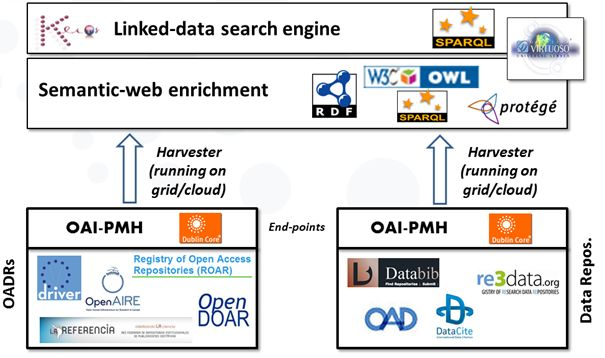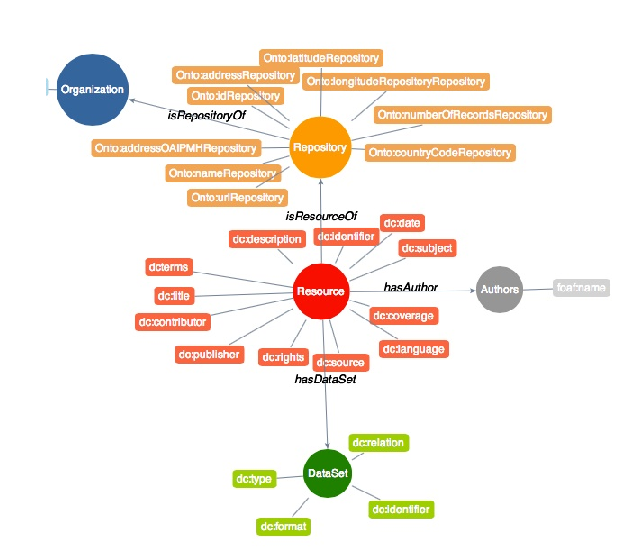Authors: Eveline Wandl-Vogt, Roberto Barbera, Giuseppe La Rocca, Antonio Calanducci, Tibor Kalman, Thordis Ulfarsdottir, Jozica Skofic, Jadwiga Waniakova
Category: Paper:Poster
Keywords: Research Infrastructure; Open Science Commons; Lexicography; Lexicology; Collaboration
Beyond Digital Humanities? Furthering the Exploration of Language Diversity and Pan-European Culture by Means of Transdisciplinary Research Infrastructures: Introducing the new DARIAH CC Science Gateway
1. Introduction
The Core Project EGI-Engage
Th is paper introduces into a new Science Gateway, developed in the framework of
the European Horizon 2020 project EGI- Engage (Engaging the Research Community towards an Open Science Commons ). EGI-Engage
aims to accelerate the implementation of the Open Science Commons by expanding the capabilities of a European backbone of federated services for compute, storage, data, communication, knowledge and expertise, complementing community-specific capabilities (EGI-Engage).
Within EGI-Engage there are several clusters of research infrastructures, representing different research communities.
The Arts and Humanities are represented by DARIAH, building the DARIAH Competence Centre (DARIAH CC).
In this paper we focus on transdisciplinary collaboration in the framework of eLexicography in cultural context.
In the last decade it becomes almost impossible to image excellent science without support of e-Infrastructures in the sciences. However, although various research areas, such as medicine, chemistry, and physics, mostly depend on the availability of advanced research infrastructure, the area of Arts and Humanities is still not utilizing the available infrastructure at their full potential, especially but not exhaustively on the example of EGI infrastructures.
To overcome this gap, DARIAH CC aims to provide a wider and more efficient access to, and use of, research e-Infrastructures at EGI level, including transnational access as well as joint research and networking for user s coming from the areas of the Arts and Humanities.
The first step in achieving this goal is by providing end-user support, at both technical and service level. One way of fulfilling this mission is by providing a workflow-based Science Gateway.
2. Customising the Long Tail of Science (LToS)
Science Gateway and the Semantic Search Engine (SSE) for the Humanities
For the specific research domain of eLexicography, a Science Gateway is adapted and tailored to meet the needs of the user community coming from the field of Arts and Humanities or, in a more general case, from the Social Science and Humanities. Technically the Science Gateway is based on the generic purpose grid and cloud user support environment (gUSE/WS-PGRADE; LPDS [2015] ) as well as gLibrary technologies ( INFN [2015] ).
The new gateway provides access and compute services for data residing in distributed grid and cloud storages, generic applications, as well as computational resources. The usefulness and evaluation of the specific Science Gateway is demonstrated with two specific pilot applications: “Storing and Accessing DARIAH contents on EGI” (SADE), and “Multi-Source Distributed Real-Time Search and Information Retrieval” (SIR). After the end of the EGI DARIAH CC, it results will be contributed to DARIAH-EU through the DARIAH Virtual Competence Centre 1 “eInfrastructures”, which will take appropriate means to support and maintain the results.
From the Semantic Search Engine (SSE) you can search in parallel and in more than 100 languages across various Linked Data repositories:
1) the e-Infrastructure Knowledge Base (KB) containing more than 30 million resources belonging to thousands of semantically enriched Open Access Document Repositories and Data Repositories s earch results are ranked according to the R anking Web of Repositories.
2) several resources that are essential for the Arts and Humanities SADE use case in context of cultural lexicography. In this poster we focus on Biodiversity and linguistic diversity and show results for European Repositoris dealing especially with this topic, e.g. Europeana, Cultura Italia, Isidore, O pen Agris and Bio2RDF .
Others can simply added using the configuration options.
According to the Humanities requirements, further possibilities are at the moment i nvestigated to be included, e.g. AGROVOC, GEONAMES, GERMANET, ISLEX as well as DBPedia.
Furthermore, the team is investigating into supporting ALE w orkflow opportunities.
From the SSE one can right now search for your plant names and get a full list of results according to the EGI-ontology.
Figure 1 gives an overview on the science gateway archidecture:

Figure 2 below shows first search results for the search term “bellis perennis”:

F or each item you can click on:
- "More Info" to get more additional information about the dataset
- "Check citations on Google Scholar"
- "Linked Data" to display graphically the semantic connections.
- Access directly the repository where data are stored.
Instructions to access the LTOS SG can be found here.
Figure 3 below introduces the SSE-schema:

3. Exploring cultural diversity and multilinguality
Supporting ALE and COST ENeL
The certain use case is developed to support Pan-European Lexicography and Lexicology and explore new methods of scholarship . The main use case partners are members of the two European initiatives in the fields, namely for Lexicography the COST action IS 1305 European network for electronic Lexicography (ENeL) and for Lexicology the Atlas Linguarum Europae (ALE).
Both of these initiatives aim to explore cultural diversity against the background of multilingual Europe. Europe, as “common space of knowledge” with a common background for lexicography and with shared lexicographical practices and methodological principles, was to this regards influenced by a common canon of dictionaries and other reference works rather than as independent works ( Haß [2010] ; Kirkness [2012]) .
Moreover, the purpose of these dictionaries was to contribute to nation-building, which explains their – usually strong – monolingual view. Yet, this does not adequately reflect the common Pan-European linguistic heritage ( Munske / Kirkness [1996] ; Habermann [1999]) of the languages of Europe, which have been in fact in permanent contact with each other ( COST Memorandum of Understanding) .Possibilities to study the Pan-European commonal i ties are explored in the framework of COST ENeL and are to be supported by the science gateway and DARIAH Competenc e Centre.
The Use Case definitely meets user needs: The Memorandum of Understanding for the COST action ENeL [ COST MoU p: 6] refers directly to the lack of common approaches and lacking standards as well as the ambition to “fully explore the possibilities of the digital medium”.
The developed Science Gateway is one of the solutions for some of the items aimed to be results of the COST ENeL action Working Group 4 “Lexicography and Lexicology from a Pan-European perspective” (COST / Wandl-Vogt / Nowak) , namely mainly 1) Developing ways in which already existing information from single language dictionaries can be displayed and interlinked to present more adequately their common European heritage – 2) Finding new applications for the very large amount of interconnected dictionary information from the European dictionary portal in the field of digital humanities [ COST MoU : 14]. Main topics to be addressed in this paper are forms of scholarship and production of knowledge ( Nowotny / Scott / Gibbons [2003]) – a) collaborative – b) explorative – c) interdisciplinary transdisiplinary / in the framework of Open S ci ence.
a ) Collaborative: The proposers of the paper discuss how open online collaboration is furthering research on the examples of ALE and COST EneL.
b) Explorative: The authors of the paper introduce how their developed and adapted infrastructure supports explorative scholarship.
c) Interdisiplinary, transdisciplinary, towards Open Science: Finally, they reflect their transdisciplinary collaboration – with background in sciences as well as Humantities – and the added value of it on the one hand; on the other hand they reflect on transforming their workflows towards Open Science Commons.
4. Conclusion and Outlook
Beyond Digital Humanities?
This paper presents a collaboration beyond Digital Humanities: The contributors introduce into a new science gateway for the Digital Humanities, discuss the main technologies adopted and developed and point at the added value of a collaboration beyond Digital Humanities.
- A gricultural Management Standard s (2016) AGROVOC: http://aims.fao.org/access-agrovoc (Accessed: 12 March 201 6 ).
- Cybermetrics Lab (2016). Ranking Web of Repositories. http://repositories.webometrics.info/ (Accessed: 31 October 2015).
- European Cooperation in the Field of Scientific and Technical Research (COST; 2013/05). Memorandum of Understanding for the Implementation of a European Concerted Research Action designated as COST Action IS 1305: European Network of e-Lexicography (EneL). http://w3.cost.eu/fileadmin/domain_files/ISCH/Action_IS1305/mou/IS1305-e.pdf (Accessed: 12 March 201 6 ).
- European Cooperation in the Field of Scientific and Technical Research (COST; 2015 ). COST Action IS 1305: European Network of e-Lexicography (EneL). http://www.cost.eu/COST_Actions/isch/IS1305 (Accessed: 12 March 2016).
- European Grid Infrastructure (2015). EGI-Engage. https://www.egi.eu/about/egi-engage ( A ccessed: 12 March 2016).
- European Grid Infrastructure (2015). L ong Tail of Science (LToS) – Gateway. DARIAH Competence Centre Semantic Search Engine: https://csgf.egi.eu/dariah-sse (Accessed: 31 October 2015).
- European Network of E-Lexicography (ENeL) / Wandl-Vogt, E. , Nowak, K. (2014-): WG4: Lexicography and Lexicology from a Pan-European Perspective. http://www.elexicography.eu/working-groups/working-group-4/wg4-objectives/ (Accessed: 12 March 201 6 ).
- Food and Agriculture Organisation of the United Nations (2016): Agris. http://agris.fao.org/openagris/index.do (Accessed: 31 October 2015).
- Habermann, M. (1999). Latein – Muttersprache Europas, Der Deutschunterricht 3: 2 5-37.
- Haß, U. (201 0 ). Chancen und Perspektiven der historischen Lexikografie des Deutschen. In Lexicographica 2011: 45-62. https://www.unidue.de/imperia/md/content/germanistik/hass/lexicographica_2011_hass_hist_lex_d_deutschen.pdf (Accessed: 12 March 201 6 ).
- Instiuto Nationale Fisica Nucleare (INFN) (2015). gLibrary. Digital Libraries on the Grid. https://glibrary.ct.infn.it/glibrary_new/index.php(Accessed: 31 October 2015).
- Kirkness, A. (2012). Deutsches Wörterbuch von Jakob und Wilhelm Grimm. In Haß, U. ( ed .), Große Wörterbücher und Lexika Europas. Europäische Enzyklopädien und Wörterbücher in historischen Porträts . Berlin/Boston, DeGruyter, p p: 211-232.
- LPDS, Institute for Computer Sciences and Control, Hungarian Academy of Sciences (2015). Grid and cloud user support environment. http://guse.hu/documentation(Accessed: 31 October 2015).
- Munske, H.H. ; Kirkness, A. (1996). Eurolatein. Das griechische und lateinische Erbe in den europäischen Sprachen, Reihe Germanistische Linguistik (RGL), Tübingen, Niemeyer .
- Nowotny, H. ; Scott, P.; Gibbons, M . 2003. `Mode 2´ Revisited. The new Production of Knowledge. Minerva 41: 179-194. http://www.uni-klu.ac.at/wiho/downloads/nowotny.pdf . (Accessed: 12 March 201 6 ).
- SCI-GaLA (2015). Map of Open Document Repositories (OADRS). http://www.sci-gaia.eu/einfrastructures/ knowledge-base/oadr-map/ (Accessed: Oct, 31st 2015).
- The Arni Magnussen Institute for Icelandic Studies (2016). ISLEX: An Islandic – Scandinavian Multilingual Dictionary . http://www.arnastofnun.is/page/islex_en (Accessed: 12 March 201 6 ).
